Local Health Reports
Schroeder Center affiliated faculty have authored reports on a broad range of topics in healthcare and health policy.
Health Status and Health Behaviors
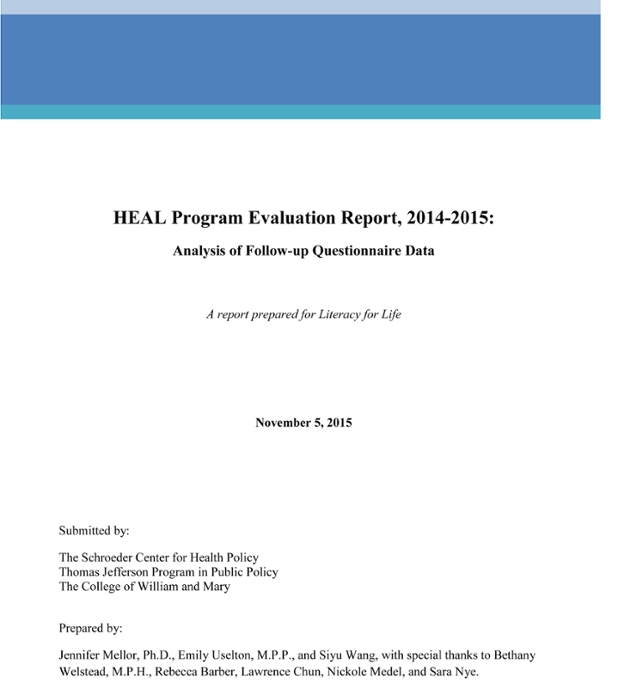 |
2014-2015 HEAL® Program Evaluation Report: Follow-UpLiteracy for Life provides many services to the greater Williamsburg community, including an innovative program called HEAL. The HEAL program seeks to improve the health of adults using two approaches – HEAL classes and the training of medical professionals. The overall objectives of the HEAL classes are to increase participants’ basic knowledge of the healthcare system and to build their confidence in navigating the healthcare system. HEAL classes are taught to groups of learners, including both low-literate native English-speaking adults and non-native English speakers. Eight different weekly classes delivered in a sequence comprise this part of the HEAL program. This report examines changes in the confidence and/or knowledge of learners who participated in HEAL classes between August 2014 and June 2015 using pre-questionnaires, post-questionnaires, and follow-up questionnaires completed approximately eight weeks after the program ended. The report presents findings on changes in confidence and/or knowledge eight weeks after program completion, characteristics of those who experience the larger improvements in confidence and/or knowledge that last at least eight weeks after program completion, and participant satisfaction with HEAL classes eight weeks after program completion. This report was prepared by Jennifer Mellor (Ph.D.) Emily Uselton (M.P.P.), and Siyu Wang, with special thanks to Bethany Welstead (M.P.H.), Rebecca Barber, Lawrence Chun, Nickole Medel, and Sara Nye. |
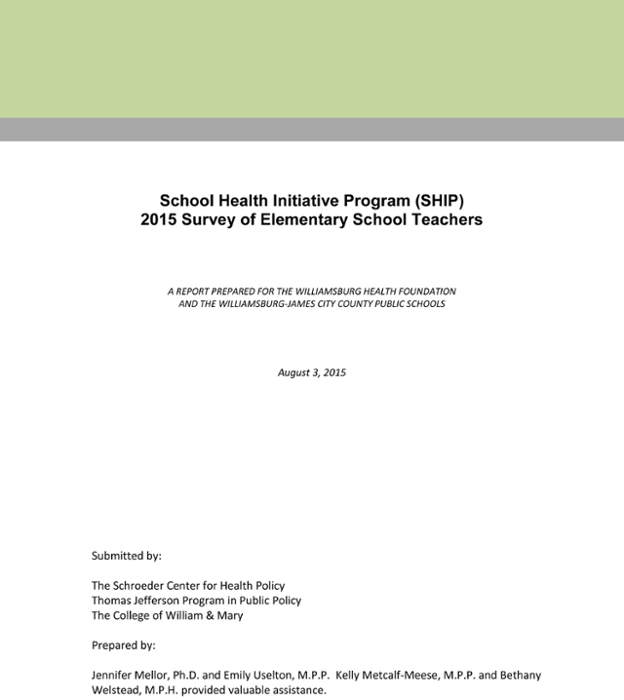 |
2015 School Health Initiative Program (SHIP) Survey Report: Elementary School TeachersThis report presents findings from the annual survey of elementary school teachers in the Williamsburg-James City County Public Schools (WJCCPS) administered in the spring of 2015. The SHIP survey collected data about teachers’ perceptions of their students’ health and health behaviors, teachers’ comfort with and use of healthy lifestyle lessons in the classroom, the challenges teachers face in integrating healthy lifestyle lessons into the classroom, supports that would help teachers better integrate these healthy lifestyle lessons into the core curriculum, availability of physical activity resources in teachers’ classrooms and the students’ use of these resources, teachers’ interactions with Wellness Integration Specialists, and teachers’ perceptions of school cafeteria food quality and their own frequency of eating cafeteria food. This report examines changes in teachers’ responses between 2014 and 2015 as well as between 2013 and 2015, when possible. The report also examines differences in teachers’ responses by school, grade level, and their experience with the SHIP program, looking at responses across SHIP focus schools and non-focus schools. This report was prepared by Jennifer Mellor (Ph.D.) and Emily Uselton (M.P.P.), with the assistance of Bethany Welstead (M.P.H.) and Kelly Metcalf-Meese (M.A.). |
 |
2014-2015 HEAL® Program Evaluation ReportLiteracy for Life provides many services to the greater Williamsburg community, including an innovative program called HEAL. The HEAL program seeks to improve the health of adults using two approaches – HEAL classes and the training of medical professionals. The overall objectives of the HEAL classes are to increase participants’ basic knowledge of the healthcare system and to build their confidence in navigating the healthcare system. HEAL classes are taught to groups of learners, including both low-literate native English-speaking adults and non-native English speakers. Eight different weekly classes delivered in a sequence comprise this part of the HEAL program. This report evaluates the HEAL classes offered between August 2014 and June 2015 using a quasi-experimental pre-test/post-test study design consisting of questionnaires administered at the start of the eight week class and again at the end of the eight week class. The evaluation also examines a comparison group of individuals who did not participate directly in the HEAL program. The report presents findings on the characteristics of HEAL program participants, improvements in their confidence and/or knowledge of health-related issues, characteristics of those who experience the larger improvements in confidence and/or knowledge, and participants’ satisfaction with the program. This report was prepared by Jennifer Mellor (Ph.D.) and Emily Uselton (M.P.P.), with special thanks to Bethany Welstead (M.P.H.), Rebecca Barber, Lawrence Chun, Nickole Medel, and Sara Nye. |
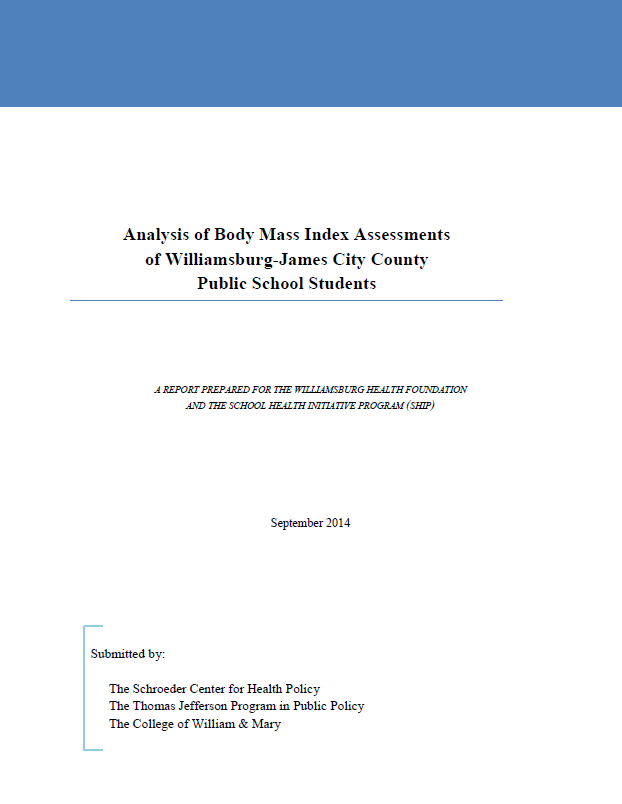 |
2014 Analysis of Body Mass Index (BMI) Assessments of Williamsburg-James City County Public School (WJCCPS) StudentsThe 2014 School Health Initiative Program (SHIP) BMI Report summarizes findings from WJCCPS physical education departments’ annual assessments of students’ body mass indices. Schroeder Center staff calculated the proportion of WJCCPS students in grades 4-12 in each weight category (obese, overweight, healthy weight, and underweight) and then compared these proportions between 2013 and 2014. The report also examines differences in the proportions of obese and overweight students by sex, race/ethnicity, free/reduced price lunch eligibility, and grade level. The report was prepared by Jennifer Mellor (Ph.D.) and Bethany Welstead (M.P.H.), with input from Amy Lazev (Ph.D.), the SHIP Coordinator. |
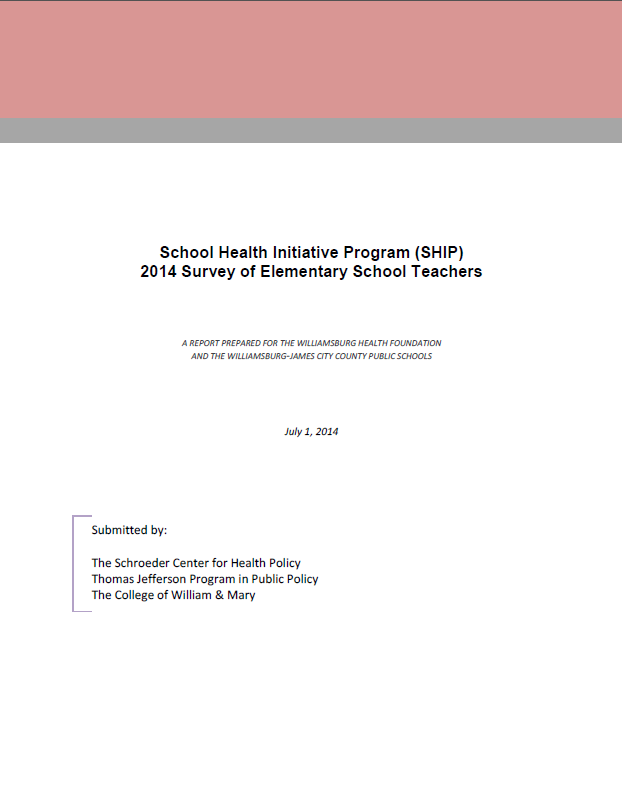 |
2014 School Health Initiative Program (SHIP) Survey Report: Elementary School TeachersThis report presents findings from the annual survey of elementary school teachers in the Williamsburg-James City County Public Schools (WJCCPS) administered in the spring of 2014. The SHIP survey collected data about teachers’ perceptions of their students’ health and health behaviors, teachers’ comfort with and use of healthy lifestyle lessons in the classroom, the challenges teachers face in integrating healthy lifestyle lessons into the classroom, and supports that would help them to better integrate these healthy lifestyle lessons into the core curriculum. This report examines changes in teachers’ responses between 2013 and 2014 and differences in teachers’ responses by school. The report also examines differences in teachers’ responses by their experience with the SHIP program, looking at responses across SHIP focus schools and non-focus schools as well as by teachers’ previous years of experience with Wellness Integration Program specialists. This report was prepared by Jennifer Mellor (Ph.D.) and Bethany Welstead (M.P.H.), with the editorial assistance of Kelly Metcalf-Meese (M.A.). |
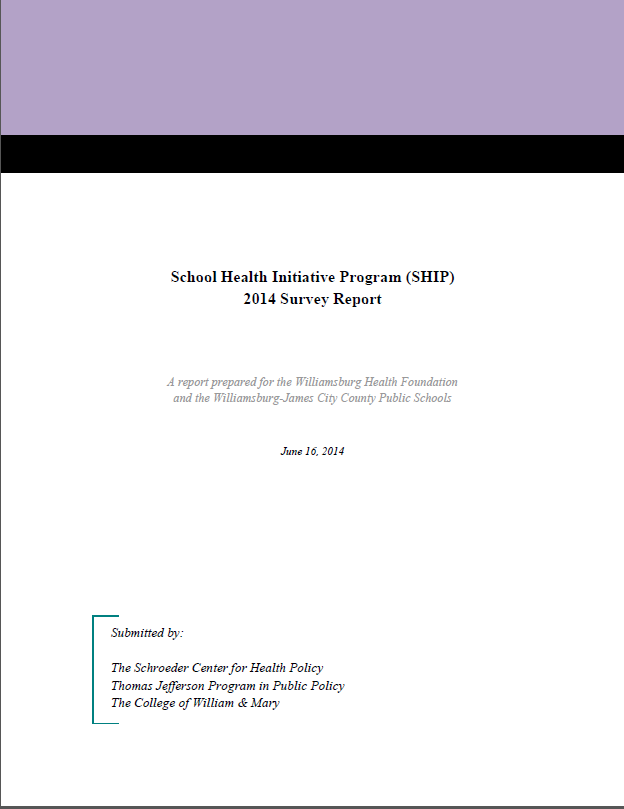 |
2014 School Health Initiative Program (SHIP) Survey Report: Middle/High School Students and Elementary School ParentsThe 2014 SHIP Survey Report details findings from the most recent round of data collection, conducted via two surveys administered in Williamsburg-James City County Public Schools (WJCCPS) during the fall of 2014. A survey of middle and high school students evaluated students’ health behaviors, knowledge, and attitudes, and a survey of elementary school parents evaluated students’ health behaviors and parents’ health knowledge and attitudes. The report analyzes changes in WJCCPS student behavior between 2010 and 2013 and identifies differences in outcomes and behaviors across groups of students defined by race/ethnicity, sex, school level, and school. The report also examines the relationships between key outcomes (like SHIP Challenge Club participation and unhealthy beverage consumption) and other factors of interest. This report was prepared by a team of contributors led by project director Jennifer Mellor (Ph.D.). Bethany Welstead (M.P.H.) conducted the data analysis, and Emily Uselton (M.P.P., Class of 2015) and Kelly Metcalf-Meese (M.A.) provided invaluable support with the report writing and editing. Rebecca Barber (Class of 2015) and Ashley Gray (M.P.P.) helped with survey editing and distribution. |
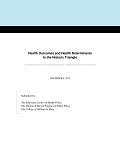 |
“Health Outcomes and Health Determinants in the Historic Triangle”This report inventories and reviews existing data on health outcomes and health factors for the Historic Triangle of Virginia, defined here as the area consisting of James City County, York County, and the City of Williamsburg. The most recent releases of the County Health Rankings (CHR) report and the Virginia Atlas of Community Health are assembled, reviewed, and supplemented by city- and county-level data from state and federal agencies. This report includes a narrative that seeks to: 1) compare the health of the populations of Williamsburg, James City County, and York County to the health of the Virginia population as a whole, 2) compare the health of the populations of the three individual localities in the Historic Triangle to one another, 3) look for trends in population health over time, and 4) identify health issues where additional measures may be useful and where additional steps may be valuable for the community. Read the full report or a brief that summarizes key findings. This report was prepared by Jennifer M. Mellor (Ph.D.), Elizabeth Vestal (J.D., M.P.P.), and Carrie Dolan (M.P.H.). Kelly Metcalf-Meese (M.A.) and Joel White (W&M Class of 2013) provided valuable research assistance. This report was funded by a generous grant from the Williamsburg Health Foundation. |
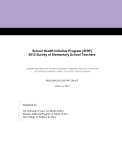 |
"School Health Initiative Program (SHIP) 2012 Survey of Elementary School Teachers"As part of the evaluation of the School Health Initiative Program (SHIP) in the Williamsburg-James City County Public Schools, SHIP staff and external evaluators conduct an annual survey of elementary school teachers known as the SHIP Teacher Survey. The purpose of the SHIP Teacher Survey is to provide valuable information on: teachers’ perceptions of the health of their students; teachers' motivation, comfort and use of healthy lifestyle lessons; the challenges teachers face in incorporating healthy lifestyle information into the core curriculum; and the types of supports teachers would like to receive to better incorporate healthy lifestyle information into the core curriculum. This report summarizes key findings from the 2012 Teacher Survey. Elizabeth Vestal (J.D., M.P.P.) completed this report under the direction of Jennifer M. Mellor (Ph.D.). |
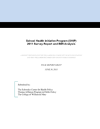 |
"Parental Engagement Study, 2012"School-based nutrition and physical activity programs traditionally address children’s behaviors, but often fail to understand the important influences of parents on children’s habitual dietary and physical activity habits. Funded by the Williamsburg Health Foundation, the School Health Initiative Program (SHIP) has recently made efforts to increase parental engagement with its programs. In order to improve such efforts, Scott Ickes (Ph.D.) and Carrie Dolan (M.P.H.) conducted a qualitative research study among parents with children in the Williamsburg-James City County Public Schools. |
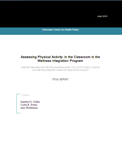 |
"School-Based Obesity Prevention Programs Literature Review, 2012"Elizabeth Vestal (J.D., M.P.P.) and Joel White (W&M Class of 2013) conducted a literature review for the Williamsburg-James City County Public Schools’ School Health Initiative Program (SHIP) to identify school-based programs that have documented statistically significant positive outcomes related to healthy eating, physical activity, and/or BMI scores. The review documents over 15 studies on successful programs targeting students and staff. |
 |
"School Health Initiative Program (SHIP) 2011 Survey Report and BMI Analysis"This report presents findings from data collection and analysis of SHIP during the 2010-2011 academic year. SHIP is a comprehensive multi-year program designed to encourage healthy behaviors among Williamsburg-James City County Public School (WJCCPS) students, staff, and their families. Findings include results from student and parent surveys administered in the fall of 2010 as well as a BMI analysis of WJCCPS third, fifth, and seventh grade students assessed in the spring of 2011. Findings are also compared to prior results from surveys administered in 2006 and 2008 and BMI assessments conducted in 2006 and 2009. William & Mary graduate and undergraduate students in Public Policy aided the Schroeder Center in collecting and analyzing data for this report under the direction of Jennifer M. Mellor (Ph.D.), Principal Investigator. Carrie Dolan (M.P.H.) conducted the geospatial analysis of BMI data, and Ron Rapoport (Ph.D.) led the redesign and fielding of the parent survey. Visit SHIP The Schroeder Center's role in the evaluation of the School Health Initiative Program in the Williamburg-James City County Public Schools was featured in the 2010 President's Report. |
 |
"Assessing Physical Activity in the Classroom in the Wellness Integration Program"The Wellness Integration Program, or WIP, is a key component of the Williamsburg-James City County Public Schools' School Health Initiative Program (SHIP). Through the quantitative analysis of a natural experiment, this report describes differences in student physical activity and teacher behavior between two WIP and two non-WIP schools, and differences in physical activity by grade, student gender, and time of day. |
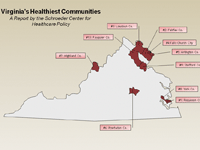 |
"Virginia's Top Ten Healthiest Communities"This report uses a broad set of population-based indices to identify and rank the top ten healthiest communities in the state of Virginia. Rankings were based on overall mortality, death rates related to cancer and heart disease, as well as rates of poverty, obesity, and smoking. The city of Poquoson - with its low crime rates, low poverty rates, and low prevalence of sexually transmitted diseases - received the top spot. The rest of the top ten healthiest communities are, in descending order, Fairfax County, Loudoun County, Falls Church, Arlington County, Powhatan County, Highland County, York County, Stafford County, and Fauquier County. Overall Ranking (pdf) Methods (pdf) |
Access to Healthcare
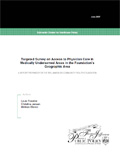 |
"Targeted Survey on Access to Physician Care in Medically Underserved Areas"Threatened reductions in the fee rates paid to physicians by Medicare have raised concerns that persons in some market areas may have difficulty obtaining the care they need in a timely manner. This report presents results from a 2007 survey targeted to persons with a limited ability to pay for health-related services and residing in medically underserved areas. The study identifies which people experience problems in accessing physician services and the reasons they state for these challenges. Full Report (pdf) |
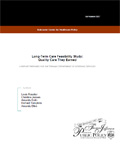 |
"Long-Term Care Feasibility Study: Quality Care They Earned"With approximately 728,000 veterans, Virginia's veteran population is the 11th largest in the nation. This report examines the current and future long-term care needs of veterans and makes recommendations for new services and facilities. Specifically, study authors recommend placing new veterans care centers in Northern Virginia, the Danville City area, and either Southwest Virginia, Southside Virginia, or the Eastern Shore. In addition, the study recommends that the state begin to build a continuum of long-term care services. Full Report (pdf) |
Healthcare Financing and Delivery
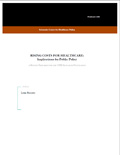 |
"Rising Costs of Healthcare"Much is right about American healthcare, such as relatively high life expectancies and improvements in mortality rates for certain disease categories. Americans also enjoy choices among insurers and providers. But there are unacceptable disparities, costs are rising rapidly, and some aspects of employer-based insurance are problematic. Full Report (pdf) |
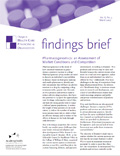 |
"Pharmacogenomics: An Assessment of Market Conditions"Pharmacogenomic studies are used to discern an individual's susceptibility to disease based on genetic makeup, and can enable physicians to identify patients who will have an adverse reaction to a drug by comparing a drug treatment with a genetic test. This study examines whether or not pharmacogenomic products and services have the potential to flourish in the current financing, delivery, and payment environment. |














